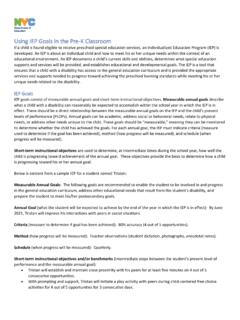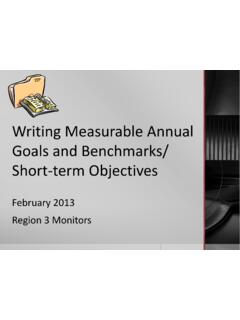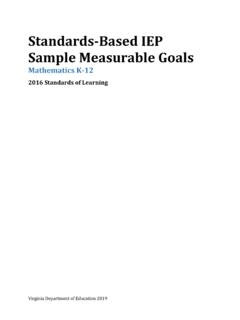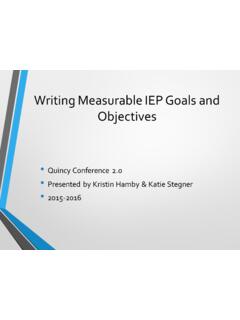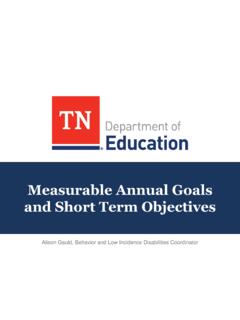Transcription of Transition Goals in the IEP - AB SpEd PAC
1 Transition Goals in the IEP September 2010 In Transition to Adulthood, we presented an overview of what IDEA 2004 requires in terms of Transition planning for youth with disabilities. A significant aspect of the law s requirements relates to including Transition -related Goals and statements in the IEPs of students preparing for life after high school. Now it s time to take a much closer look at the kind of information you might include in a student s IEP as part of Transition planning. Index First, What IDEA Requires NSTTAC s List of Questions to Ask NSTTAC Example: Education/Training NSTTAC Example: Employment NSTTAC Example: Independent Living IEP Goals to Help the Student Achieve Postsecondary Goals Matching Transition Services to the Postsecondary Goals and the IEP Goals In Conclusion Back to top First, What IDEA Requires Let s start by revisiting IDEA s provisions at (b) regarding what must be included in a student s IEP no later than when that student turns 16: (b) Transition services.
2 Beginning not later than the first IEP to be in effect when the child turns 16, or younger if determined appropriate by the IEP Team, and updated annually, thereafter, the IEP must include (1) Appropriate measurable postsecondary Goals based upon age appropriate Transition assessments related to training, education, employment, and, where appropriate, independent living skills; and (2) The Transition services (including courses of study) needed to assist the child in reaching those Goals . Breaking the provisions at (b) into their component parts is a useful way to see what needs to be included, Transition -wise, in the student s IEP.
3 For example, consider: Postsecondary Goals must Appropriate, measurable Postsecondary Goals must also be based Age-appropriate Transition assessment Transition assessment ind T ra in in g , e d u c a tio n , e m p lo y m e n t, in d e p e n d e n t liv in g s k ills , where appropriate Transition services Courses of study Transition services for a student as those that the student To assist the child in reaching those Goals What Goals ? The postsecondary Goals The discussion below is intended to illuminate how these provisions are to be implemented in the real world, with real students.
4 Back to top NSTTAC s Checklist of Questions to Ask NSTTAC is the National Secondary Transition Technical Assistance Center, an OSEP-funded project whose expertise secondary Transition . As part of its work, NSTTAC has developed extensive training materials to help states collect data about the Transition services they provide to youth with disabilities (called Indicator 13). Those materials are also useful for our purpose here, which is to look closely at the type of Transition information to include in a student s IEP. NSTTAC s materials include a checklist of questions to ask, which are adapted here for use by IEP teams as they plan a student s Transition services and craft statements to include in the student s IEP.
5 Is there a measurable postsecondary goal or Goals for the student? Can the goal(s) be counted? Does the goal(s) occur after the student graduates from school? Are the postsecondary Goals based on an age-appropriate Transition assessment? Are there annual IEP Goals that reasonably enable the child to meet the postsecondary goal(s) or make progress toward meeting the goal(s)? Are there Transition services (including courses of study) in the IEP that focus on improving the academic and functional achievement of the child to facilitate his or her movement from school to post-school?
6 Do the Transition services listed in the IEP relate to a type of instruction, related service, community experience, development of employment and other post-school adult living objectives (and, if appropriate, acquisition of daily living skills), and provision of a functional vocational evaluation? Are representatives of other agencies invited (with parent consent or the student s) to IEP meetings when Transition services are being discussed that are likely to be provided or paid for by these other agencies? NSTTAC also provides real-life examples that are as illuminating as they are helpful, especially since examples are included for three key domains of Transition planning: education/training, employment, and independent living.
7 We d like to share some of NSTTAC s examples with you. Again, we ve adapted them a bit, to make them more appropriate for use by IEP teams, but all the credit goes to NSTTAC for this work. The original material is cited as: National Secondary Transition Technical Assistance Center (2007). Indicator 13 training materials. Charlotte, NC: Author. You can find it online (and share it as widely as you like) at: Back to top NSTTAC Example: Education/Training Here s an example of a measurable postsecondary goal in the domain of education/training. Upon completion of high school, John will enroll in courses at Ocean County Community College.
8 This goal meets NSTTAC s standard because of specific reasons: Participation in postsecondary education is the focus of this goal. Enrollment at a community college can be observed, as in John enrolls in courses or he does not. The expectation, or behavior, is explicit, since John enrolls at the community college or he does not. Enrollment at a community college occurs after graduation, and it is stated that this goal will occur after graduation. NSTTAC also generously provides nonexamples. For the goal statement above: Nonexample: Upon graduation, John will continue to learn about life skills and reading.
9 NSTTAC says that this statement does not meet the standard, because: Participation in learning is the focus of this goal, but no specific place or program is specified. The expectation for learning, or behavior, is not explicitly stated. Helpful, eh? Also consider these two NSTTAC comments about the writing of education/training Goals : There would likely be less specificity in the postsecondary Goals articulated by younger students, than those in their last years of high school. John s goal could be made more specific by including a phrase such as will enroll in the general Associates Degree program It is not necessary to specify the student s major for the goal to be measurable.
10 However, increased specificity in postsecondary goal statements (when the student articulates this information) can improve the relevance of services provided during high school. If you d like to see more examples (and nonexamples!) of postsecondary Goals for education/training, you can find them at: Back to top NSTTAC Example: Employment Now let s look at an example of a measurable postsecondary goal in the domain of employment. John will work in an on-campus part-time job while in college. This goal is well-crafted, because: Obtaining employment is the focus of the statement. Working part-time is an explicit outcome that can be observed.
